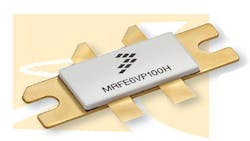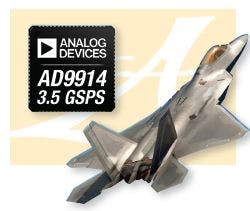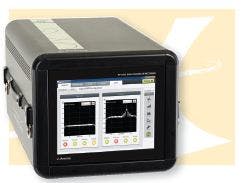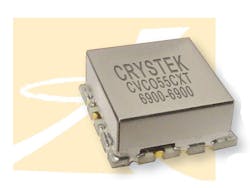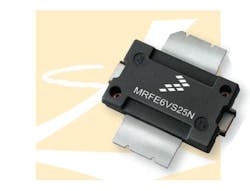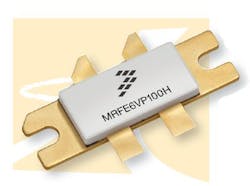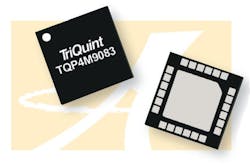Held in Canada for only the second time in its history, the 2012 IEEE International Microwave Symposium (IMS) brought a large influx of microwave engineers to Montreal, Quebec in celebration of the RF/microwave industry and its technologies. What follows is a sampling of some of the new product announcements made by proud exhibitors during the event.
Analog Devices (www.analog.com) opened more than a few eyes with its various integrated-circuit (IC) technologies, including new high-speed direct-digital-synthesizer (DDS) sources. The firm’s latest DDS products unveiled at the show, the model AD9914 with a speed of 3.5 GSamples/s and the model AD9915 with a speed of 2.5 GSamples/s, are both capable of producing frequency-agile, analog output sinusoidal waveforms to 1.4 GHz, suitable for use in both commercial and military applications. The sources work with an on-chip digital-to-analog converter (DAC) for high-speed signal generation. The new DDS sources feature a 32-b parallel port that enables fast changes in frequency, phase, and amplitude of the output signal. The AD9914 (Fig. 1)and AD9915 settle in nanoseconds with granularity well below 200 pHz with better than −50 dBc spurious-free dynamic range (SFDR). The DDS sources consume only about 2.5 W at full operating speed.
1. One of the fastest commercially available DDS sources, model AD9914 runs at a clock speed of 3.5 GSamples/s. [Photo courtesy of Analog Devices (www.analog.com).]
For purveyors of "old-fashioned" signal generation, the firm also announced its model ADF4159 13-GHz phase-lock-loop (PLL) frequency synthesizer. With a 110-MHz phase detector operating in fractional-N mode, and power consumption of less than 100 mW, the ADF4159 contains a 25-b fixed modulus as well as on-chip functionality to generate highly linear ramp profiles, making it suitable for use in frequency-modulated-continuous-wave (FMCW) radar applications, automotive radar, communications instrumentation, and test equipment.
For cases when communications signals must be captured for study, the RP-5300 series of RF recorders from Averna (www.averna.com) offer 50 MHz of recording bandwidth—enough to record multiple GNSS signals in as many as two bands (L1, L2, L5), such as GPS or GLONASS. The single- and dual-channel RP-5310 and RP-5320 (Fig. 2) signal recorders are compact enough for easy transport, with an integrated display to simplify use in the field.
2. Model RP-5320 is a dual-channel communications signal recorder with 50-MHz bandwidth and touchscreen display. [Photo courtesy of Averna (www.averna.com).]
The RP-5300 recorders are preloaded with Averna’s RF Studio Recorder for making painless RF recordings, managing collected data, and analyzing or playing back collected RF environments. The recorders cover a frequency range of 330 MHz to 2.5 GHz, with full coverage of the full L1, L2, and L5 bands. They provide as much as 11 hours of recording time when using external RAID memory.
The recorders boast impressive electrical performance, with frequency resolution of 0.1 Hz, phase noise of better than −100 dBc/Hz offset 10 kHz from a 1-GHz carrier, an input measurement range of −140 to +10 dBm, a noise floor of −170 dBm/Hz, and a typical level accuracy of ±1 dB. In addition, the field recorder offers a real-time bandwidth of 10 MHz for carriers less than 120 MHz, a real-time bandwidth of 20 MHz maximum for carriers to 330 MHz, and a real-time bandwidth of 50 MHz for carriers of greater than 330 MHz. The typical SFDR is better than 80 dB.
Crystek (www.crystek.com) displayed its model CVCO55CXT-6900-6900 coaxial resonator oscillator (CRO) for use at 6900 MHz (Fig. 3). The coaxial-based voltage-controlled oscillator (VCO) is designed for low phase noise and low harmonics. It operates at 6900 MHz with a tuning voltage range of 0.5 to 4.5 VDC. This coaxial VCO features a typical phase noise of −100 dBc/Hz offset 10 kHz from the carrier and has good linearity. The CVCO55CXT-6900-6900 CRO exhibits typical output power of +2.0 dBm into a 50-Ω load with a supply of +8.0 VDC and maximum current consumption of 35 mA. The source is supplied in an industry-standard 0.5-in x 0.5-in package.
3. The model CVCO55CXT- 6900-6900 coaxial resonator oscillator (CRO) was developed for low-noise use at 6900 MHz. [Photo courtesy of Crystek (www.crystek.com).]
CTS Electronic Components (www.ctscorp.com) offered a new solution for overcrowded cellular channels in its ClearPlex™ ceramic waveguide filter technology. Although some of these promises were frequency- and passband-dependent, the firm’s representatives referred to a technology that could provide transmit-receive isolation of better than 60 dB with power-handling capabilities exceeding 300 W on peaks. These miniature and lightweight filters would also suffer minimal insertion loss.
Empower RF (www.empowerrf.com) provided examples of its high-power amplifier technology, including its model BBM2E3KLP power amplifier, which delivers 125 W output power from 20 to 520 MHz in a module measuring just 7.0 x 4.0 x 1.5 in. Suitable for broadband jamming and high-power linear applications in the ultra-high-frequency (UHF)/very-high-frequency (VHF) bands, it builds on LDMOS transistors and also includes control, monitoring, and protection functions.
The module provides external control via RS-485 bus. The control module can actively (continuously) monitor critical performance parameters, such as temperature, current consumption, and voltage levels, while taking action via the microcontroller when necessary to protect and/or shutdown the unit to avoid PA damage.
The firm also showed its model BBS3K4AUU (SKU 22162) amplifier based on high-power LDMOS transistors for octave bands or band-specific power applications. It is designed for use from 20 to 1000 MHz with 1000 W CW output power and 800 W output power at 1-dB compression. It provides 60-dB gain at the 1-dB compression point and only required 0-dBm input power to reach the rated output-power level. The amplifier, which has a rated third-order intercept point of +69 dBm, features a 20-dB gain adjustment range. Second and third harmonics are just −20 dBc at the rated output power. The design incorporates advanced broadband RF matching networks and combining techniques and EMI/RFI filters for high performance. The amplifier and switch filter bank are constructed within one single five-rack-unit (5RU) drawer including the forced air-cooling. The amplifier includes a built in control and monitoring system, with protection functions.
For Montreal-based Focus Microwaves, travel to an IMS booth was a short trip crosstown. The company’s model iCCMT-306-S Intelligent Computer Controlled Microwave Tuner is designed for use from 600 MHz to 3.0 GHz. An integral part of many load-pull characterization systems, the iCCMT-306-S allows for full and accurate characterization of packaged and on-wafer transistors.
The iCCMT-306-S makes use of Focus’ proprietary TCP/IP capable iTuner technology with built in microprocessor and command language, allowing tuning to any interpolated impedance within the tuning range with a typical accuracy of 40 dB or better. The iCCMT-306-S can be used with Focus’ software or independently by using the Focus ActiveX control. The tuner system achieves minimum VSWR of 15:1 and typical VSWR of 30:1. It suffers only 0.12-dB insertion loss and exhibits minimum repeatability of −40 dB from 600 MHz to 3 GHz and typical repeatability of −50 dB over that frequency range. It offers phase resolution of 0.037 deg./step at 0.6 GHz and 0.183 deg./step at 3 GHz.
CTT (www.cttinc.com) launched some new compact, GaN-based solid-state power amplifiers (SSPAs) operating in the 6.4 to 11.0 GHz frequency range at the Montreal IMS. Designed for applications that include modern radar systems, the 39 GaN-based power amplifiers in the AGN and AGW series. As an example, model AGN/105-4957-P operates from 9.5 to 10.5 GHz with minimum gain of 57 dB and minimum saturated output power of 80 W.
GaN amplifier models in the two series are available with output-power levels to 160 W. They are suitable for new multifunction radar systems that effectively conserve weight, space, and power consumption though the combination of several stand-alone radars into a single system. The new amplifier products include 15 models for narrowband applications from 7.8 to 10.7 GHz in CW mode, 12 models for narrowband (less than 10% bandwidth) applications from 8.5 to 10.7 GHz in pulsed mode, and 12 wideband models for use from 6.4 to 11.0 GHz in CW mode.
Freescale Semiconductor (www.freescale.com) made some of the loudest "noise" in terms of news at the 2012 IMS by introducing its first GaN transistor, the model AFG25HW355S power device. The device promises 350 W output power from 2.3 to 2.7 GHz with 50% efficiency and 16-dB gain. The GaN transistor has potential applications in many high-powered quasi-linear and pulsed applications.
Of course, going with GaN did not mean abandoning silicon LDMOS, and Freescale had two new LDMOS devices to show at the 2012 IMS: the 25-W MRFE6VS25N (Fig. 4)and the 100-W MRFE6VP100H (Fig. 5). Both are designed to deliver full CW rated output power, handlING impedance mismatches of greater than a 65.0:1 VSWR while maintaining outstanding linearity. Target applications include HF-UHF transmitters and transceivers, television transmitters, white space data transceivers, aerospace/defense systems, and test equipment.
4. Model MRFE6VS25N is a silicon LDMOS transistor capable of 25 W output power and more than 25-dB gain through 512 MHz. [Photo courtesy of Freescale Semiconductor (www.freescale.com).]
5. Model MRFE6VP100H is a 100-W LDMOS power transistor with 26-dB gain at 512 MHz. [Photo courtesy of Free-scale Semiconductor (www.freescale.com).]
The MRFE6VS25N and MRFE6VP100H LDMOS devices allow designers to develop a single power amplifier for multiple frequency bands—such as 1.8 to 54 MHz and 30 to 512 MHz—at a cost far lower than that for GaN devices. The model MRFE6VS25N is designed to deliver 25 W CW output power and more than 26-dB gain from 1.8 to 300.0 MHz, with more than 25 dB gain at 512 MHz.
The model MRFE6VP100H provides 100 W CW output power with 26-dB gain at 512 MHz and more than 19-dB gain from 30 to 512 MHz. It has efficiency rated at 40% to 71% and, like the MRFE6VS25N, can deliver full rated performance levels into a load VSWR of greater than a 65.0:1 VSWR. The MRFE6VS25N transistor is housed in Freescale’s TO-270-2 over-molded plastic package and the MRFE6VP100H/HS transistor is supplied in Freescale’s NI-780-4 and NI-780S-4 air cavity packages.
Infineon Technologies (www.infineon.com) also introduced high-power LDMOS transistors at IMS, based on a new 50-V process technology. The new devices, aimed at pulsed applications in commercial avionics, and radar systems, include 400- and 500-W parts for L-band and UHF use as well as a 1000-W device for applications from 965 to 1215 MHz. The PTVA series of transistors includes devices capable of withstanding a minimum of 10:1 VSWR load mismatch for high reliability.
The transistors offer thermal resistance as low as 0.20°C/W for effective thermal management when using smaller heat sinks. Typical performance levels include 500 W output power with 17.5-dB gain and 65% efficiency from 390 to 450 MHz; 400 W output power with 13-dB gain and 52% efficiency from 1200 to 1400 MHz, and 1100 W output power with 15.5-dB gain and 60% efficiency from 965 to 1215 MHz.
One of the early GaN product developers, Sumitomo Electric (www.sei-device.com), was at the IMS with its extensive lines of GaN HEMTs for satcom applications. Sumitomo’s space level Quality Assurance Program assures the highest reliability and consistent performance for space grade level product. Available at frequencies through 2.5 GHz and power levels through 100 W, these devices provide reliable operation in space-based applications. The firm also unveiled several devices for L- and S-band radar systems, including the model ES/SGN2933-600D-R, a GaN HEMT device designed for +50-VDC operation. It is rated for 600 W minimum output power (+45 dBm) from 2.9 to 3.3 GHz, with typical efficiency of 50%. The transistor, which provides minimum power gain of 12.8 dB, is suitable for pulsed operation with pulses as long as 300 μs at duty cycles to 10%.
At the 2012 IMS, long-time supporter of millimeter-wave measurements, OML, Inc. (www.omlinc.com) announced that it had become an official participant in Agilent’s Solutions Partner Program, having supplied original-equipment-manufacturer (OEM) products to Agilent Technologies (www.agilent.com) since 2005. OML’s frequency extension technologies are used in a number of different instruments from Agilent, including the firm’s PNA series of vector network analyzers (VNAs), its PSG signal generators, and its PXA signal analyzer.
OML also introduced a direct-connect solution for millimeter-wave S-parameter measurements at the IMS event, offering its VxxVNA2 series VNA modules for direct use with Agilent’s PNA and PNA-X series VNAs. The VNA modules are available in waveguide bands from 50 GHz to 0.5 THz. With an upgrade to an N5260 series test set controller, additional functionality is available for mixer, transceiver, multiport, balanced/differential, and pulse applications.
Peregrine Semiconductor (www.psemi.com) used the 2012 IMS to announce expansions of its low-loss switch lines, including the additions of a single-pole, three-throw (SP3T) and single-pole, four-throw (SP4T) models. The SP3T unit, model PE42430, employs the firm’s patented UltraCMOS® technology for high performance in a small size. An on-chip decode logic function facilitates a three-pin CMOS control interface with no need for a drain-voltage pin.
The switch draws from the firm’s HaRP™ technology enhancements for low insertion loss of 0.45 dB at 1 GHz and 0.55 dB at 2.5 GHz, with high isolation of 40 dB at 1 GHz and 30 dB at 2.5 GHz. It also provides excellent electrostatic-discharge (ESD) tolerance of 4500 V human body model (HBM) and 250 V machine model (MM) on all ports, and is available in a miniature, 8-lead 1.5 x 1.5 mm DFN package.
The firm also launched a single-pole, four-throw (SP4T) absorptive switch at the show, the model PE42540, with a wide frequency range of 10 Hz to 8 GHz. The switch, with excellent linearity and fast switching time, exhibits low insertion loss of 0.8 dB at 3 GHz, 1 dB at 6 GHz, and 1.2 dB at 8 GHz, with isolation of 45 dB at 3 GHz, 39 dB at 6 GHz, and 31 dB at 8 GHz. The switch offers high linearity with an input third-order intercept point of +58 dBm. It has high ESD tolerance and can handle power levels to 1 W (+30 dBm) at 8 GHz.
Circuit-board materials supplier Rogers Corp. (www.rogerscorp.com) highlighted several additions to its lines of high-performance circuit materials: its 2929™ bondply system and its RO4835™ circuit laminate with enhanced oxidation resistance. The new 2929 bondply is an unreinforced thin-film adhesive system intended for use in high-performance, high-reliability, multilayer circuit constructions. It has a low dielectric constant of 2.9 in the z-axis at 10 GHz and loss tangent of less than 0.003, making it ideal for bonding multilayer circuit boards based on polytetrafluoroethylene (PTFE) composite dielectric materials such as Rogers’ RT/duroid® 6000, RO4000®, and RO3000® laminates. The proprietary crosslinking resin system makes this thin-film adhesive system compatible with sequential-bond processing while controlled flow characteristics; the adhesive system supports blind via fill capability with potentially predictable cutback ratios for designs requiring blind cavities. The 2929 bondply material is compatible with traditional flat press and autoclave bonding methods.
Rogers also introduced RO4835 high-frequency laminates at the 2012 IMS. These laminates are formulated with improved oxidation resistance. Oxidation can impact the performance of most thermoset circuit materials over time and at elevated temperatures, even FR-4, causing changes in dielectric constant and even in the physical dimensions of a circuit board. The RO4835 laminates are designed for demanding, high-volume circuit applications that must ensure stable, reliable performance over time and over a wide range of temperatures, without requiring costly processing methods. Low-loss RO4835 laminates, with a dielectric constant of 3.48 at 10 GHz and low loss tangent of 0.0037 at 10 GHz, feature a low z-axis coefficient of thermal expansion (CTE) of 26 ppm/°C from −55 to +288°C. This facilitates excellent plated-through-hole (PTH) reliability under a variety of processing and operating conditions.
For those in need of just about any type of component, the 2012 IMS offered the latest versions, from amplifiers to YIG oscillators. When connectors were needed for testing those components, Molex (www.molex.com) introduced a series of vertical printed-circuit-board (PCB) launch 2.4-mm compression-mount connectors geared for test and measurement applications. Usable through 50 GHz, the unique vertical configuration gives them advantages over conventional end-launch connectors, resulting in a smaller connector footprint that can be mounted anywhere on a PCB.
Skyworks (www.skyworksinc.com) also showed some new switches at the 2012 IMS, with several new models based on its reliable PIN diode technology. Model SKY12207-478LF, for example, is a high-power, single-pole, double-throw (SPDT) silicon PIN diode switch for use from 900 MHz to 4 GHz. The frequency range puts it right in the middle of WiMAX, LTE, and many other wireless systems. It handles an impressive 50 W CW power and 200 W peak power with 0.4-dB typical insertion loss and 42-dB typical antenna-to-receiver isolation.
Skyworks also introduced its model SKY12208-306LF SPDT switch, capable of covering two frequency bands, 0.02 to 0.70 GHz or 0.05 to 2.7 GHz, by changing the value of an RF choke in the surface-mount-technology (SMT) bias network. It can also handle 50 W CW power and 200 W peak power and exhibits typical insertion loss of 0.3 dB and is controlled with a positive power supply.
For truly high-power applications, the firm offers its model SKY12210-478LF SPDT switch, with a frequency range of 0.9 to 4.0 GHz. It is capable of handling 100 W CW power and 400 W peak power over that frequency range, with only 0.4-dB typical insertion loss and typically 44-dB antenna-to-receiver isolation at 2.6 GHz.
Triquint Semiconductor (www.triquint.com) came to the 2012 IMS with a new 7-b digital step attenuator (DSA). Model TQP4M9083 (Fig. 6) provides up to 31.75 dB attenuation in 0.25-dB steps and operates from 400 MHz to 3.5 GHz. Using a TTL/CMOS-compatible serial peripheral interface, the attenuator changes value with 118-ns switching speed. It suffers only 1.5-dB insertion loss at 2 GHz and has an input third-order intercept point of +55 dBm.
6. Model TQP4M9083 is a 7-b digital step attenuator (DSA) with as much as 31.75-dB attenuation in 0.25-dB steps from 400 MHz to 3.5 GHz. [Photo courtesy of Triquint Semiconductor (www.triquint.com).]
Scintera Networks, Inc.(www.scintera.com) showed its model SC1889A-00B11 RF Power Amplifier Linearizer (RFPAL) with integrated dual-RMS Power Measurement Unit (PMU). The PMU takes the place of a precision RMS power detector, an analog-to-digital converter, and a microcontroller in helping designers reduce the cost, size, and power of 3G/4G cellular infrastructure systems. The SC1889A-00B11 provides data as digital codes that are easily exported to any controller through a standard digital interface. Using only a single calibration point, the simultaneous dual-RMS power detector provides typical absolute accuracy of ±0.1 dB over the first 20 dB of the input range and ±0.5 dB over the last 10 dB of the input range for the cellular power amplifier (PA) lineup input and output. The SC1889-00B11 is packaged in a standard 64-pin, 9 x 9 mm QFN package enabling the entire solution to fit in less than 6 cm2 of board space.
Numerous firms offered compact test equipment with Universal Serial Bus (USB) interfaces. Vaunix Technology Corp. (www.vaunix.com) demonstrated models of its various Lab Brick instruments in Montreal, including members of the LSW series switch line in versions from single-pole, double-throw (SPDT) through single-pole, four-throw (SP4T) configurations. The firm also had its new models LDA-302P-H, LDA-302P-1, and LDA-302P-2 digital attenuators for applications from 10 to 3000 MHz and power levels to 10 W. These low-cost measurement accessories are powered and controlled by connection to a PC or self-powered USB hub, and are programmable from the included graphical user interface (GUI) software.
Long-time oscillator supplier Vectron International (www.vectron.com) was at the 2012 IMS with samples of its source wares—in particular, a new high-stability temperature-compensated crystal oscillator (TCXO), the model TX-801. Supplied in a tiny 5.0 x 3.2 mm package, the oscillator features ±100 ppb stability and is optimized for supporting timing requirements over modern IP based networks and meets the reduced cost and footprint expectations set by emerging timing applications.
The TX-801 TCXO is Stratum 3 compliant per GR-1244 and supports GR-1244 wander generation requirements. It achieves temperature stability of ±100 ppb from −10 to +70°C and ±280 ppb from −40 to +85°C. It can be specified with output frequencies of 8 to 26 MHz and use with a supply voltage of +3.3 VDC.
For those who needed extremely low phase noise for their system or test equipment, the firm also showed its OX-204 crystal oscillator in a standard 25.4 x 25.4 mm package. Generating sinewave outputs at a frequency of 10 MHz, the OX-204 boasts phase noise of −135 dBc/Hz offset 10 Hz from the carrier and −175 dBc/Hz offset 10 kHz from the carrier.
Last but certainly not least, Polyflon (www.polyflon.com) showed samples of its excellent CuFlon® microwave circuit-board substrates, known for their steady 2.05 relative dielectric constant at 18 GHz in the z-direction and their low dissipation factor of 0.00045, also at 18 GHz. The circuit-board material, with excellent thermal properties for use in high-power active and passive circuits, essentially combines the properties of PTFE with a proprietary plating process to create a material that supports extremely high-performance microwave circuit designs.
About the Author
Jack Browne
Technical Contributor
Jack Browne, Technical Contributor, has worked in technical publishing for over 30 years. He managed the content and production of three technical journals while at the American Institute of Physics, including Medical Physics and the Journal of Vacuum Science & Technology. He has been a Publisher and Editor for Penton Media, started the firm’s Wireless Symposium & Exhibition trade show in 1993, and currently serves as Technical Contributor for that company's Microwaves & RF magazine. Browne, who holds a BS in Mathematics from City College of New York and BA degrees in English and Philosophy from Fordham University, is a member of the IEEE.
